

高等学校化学学报 ›› 2021, Vol. 42 ›› Issue (8): 2381.doi: 10.7503/cjcu20210005
陈韶云1, 张行颖1, 刘奔1, 田杜1, 李奇1, 陈芳1, 胡成龙1( ), 陈建2
), 陈建2
收稿日期:2021-01-04
出版日期:2021-08-10
发布日期:2021-08-05
通讯作者:
胡成龙
E-mail:ceshcl@jhun.edu.cn
基金资助:
CHEN Shaoyun1, ZHANG Xingying1, LIU Ben1, TIAN Du1, LI Qi1, CHEN Fang1, HU Chenglong1( ), CHEN Jian2
), CHEN Jian2
Received:2021-01-04
Online:2021-08-10
Published:2021-08-05
Contact:
HU Chenglong
E-mail:ceshcl@jhun.edu.cn
Supported by:摘要:
采用水热法在导电玻璃FTO导电面上沉积TiO2四棱柱阵列; 并以其为基体, 分别采用聚乙烯基吡咯 烷酮(PVP)还原Tollens试剂以及柠檬酸三钠(TSC)还原硝酸银溶液, 将Ag纳米粒子(AgNPs)沉积在TiO2四棱柱阵列上形成TiO2@AgNPs-PVP和TiO2@AgNPs-TSC微纳结构作为表面增强拉曼散射(SERS)基底. 实验结果表明, Ag纳米粒子在TiO2四棱柱阵列上的尺寸和分布可通过改变Tollens试剂的浓度和TSC还原硝酸银溶液的反应时间来调控, 进而优化基底的SERS灵敏度. TiO2@AgNPs-PVP微纳结构对罗丹明6G(R6G)的检出限为10-12 mol/L, 对低活性小分子三聚氰胺的检出限为0.01 mg/mL; TiO2@AgNPs-TSC微纳结构对R6G的检出限为10-10 mol/L, 对三聚氰胺的检出限为0.01 mg/mL. TiO2@AgNPs-PVP和TiO2@AgNPs-TSC微纳结构基底的SERS活性、 循环可回收性与还原剂种类紧密相关: 包覆在Ag纳米粒子上的PVP可以作为隔离层避免Ag纳米粒子直接接触, 防止电磁场耦合作用减弱, 增强基底的SERS活性; 同时, PVP是一种水性聚合物, 有较强的亲水性, 作为循环可回收SERS基底使用时, 吸附小分子物质清洗难度较大.
中图分类号:
TrendMD:
陈韶云, 张行颖, 刘奔, 田杜, 李奇, 陈芳, 胡成龙, 陈建. Ag纳米粒子在TiO2四棱柱阵列上的可控生长及其SERS效应. 高等学校化学学报, 2021, 42(8): 2381.
CHEN Shaoyun, ZHANG Xingying, LIU Ben, TIAN Du, LI Qi, CHEN Fang, HU Chenglong, CHEN Jian. Controllable Growth of Silver Nanoparticles on TiO2 Tetragonal Prism Nanarrays and Its SERS Effect. Chem. J. Chinese Universities, 2021, 42(8): 2381.
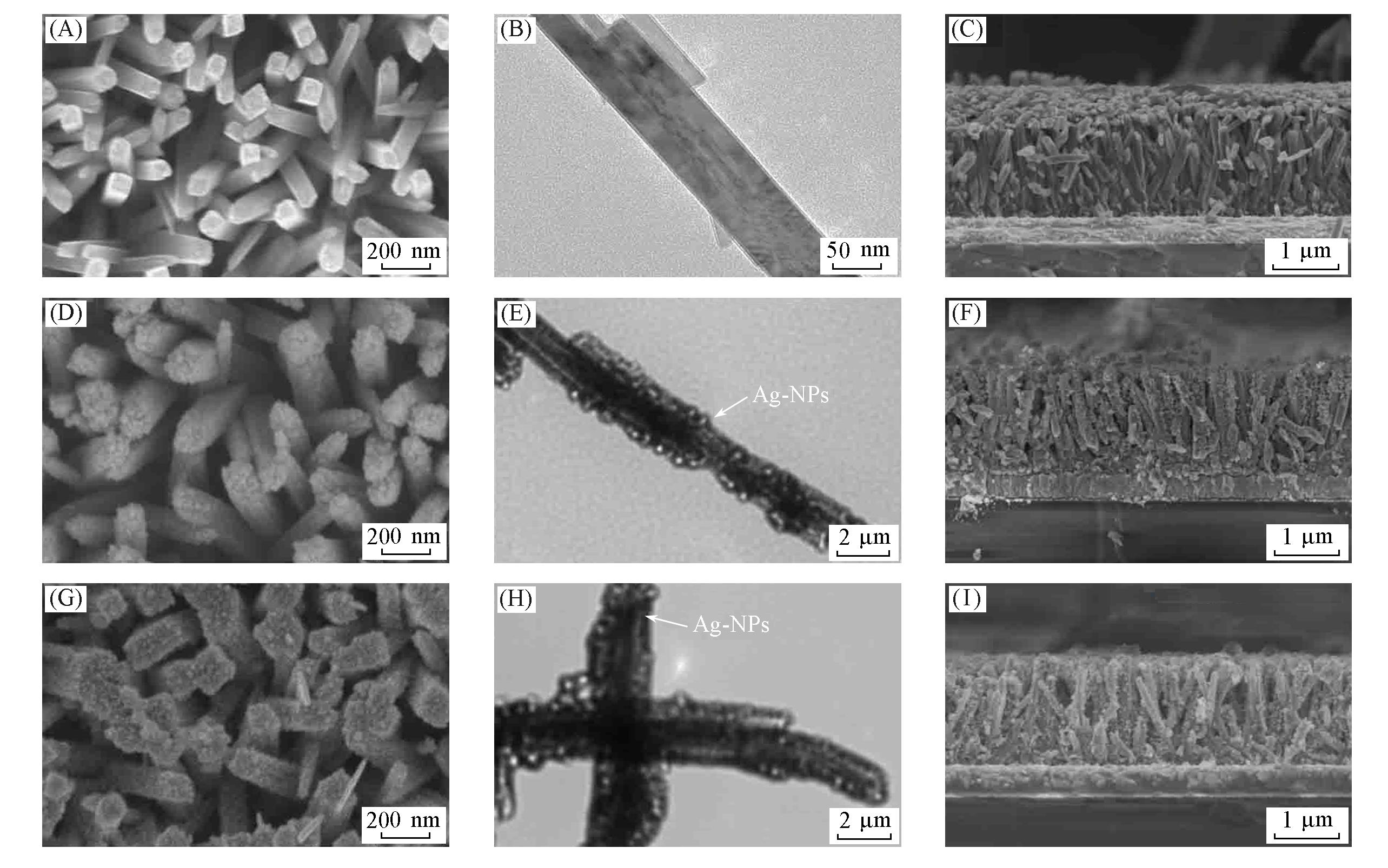
Fig.2 SEM(A, D, G), TEM(B, E, H) and cross section SEM(C, F, I) images of TiO2 tetragonal prism nanoarray(A―C), TiO2@AgNPs?PVP(D―F) and TiO2@AgNPs?TSC(G―I)
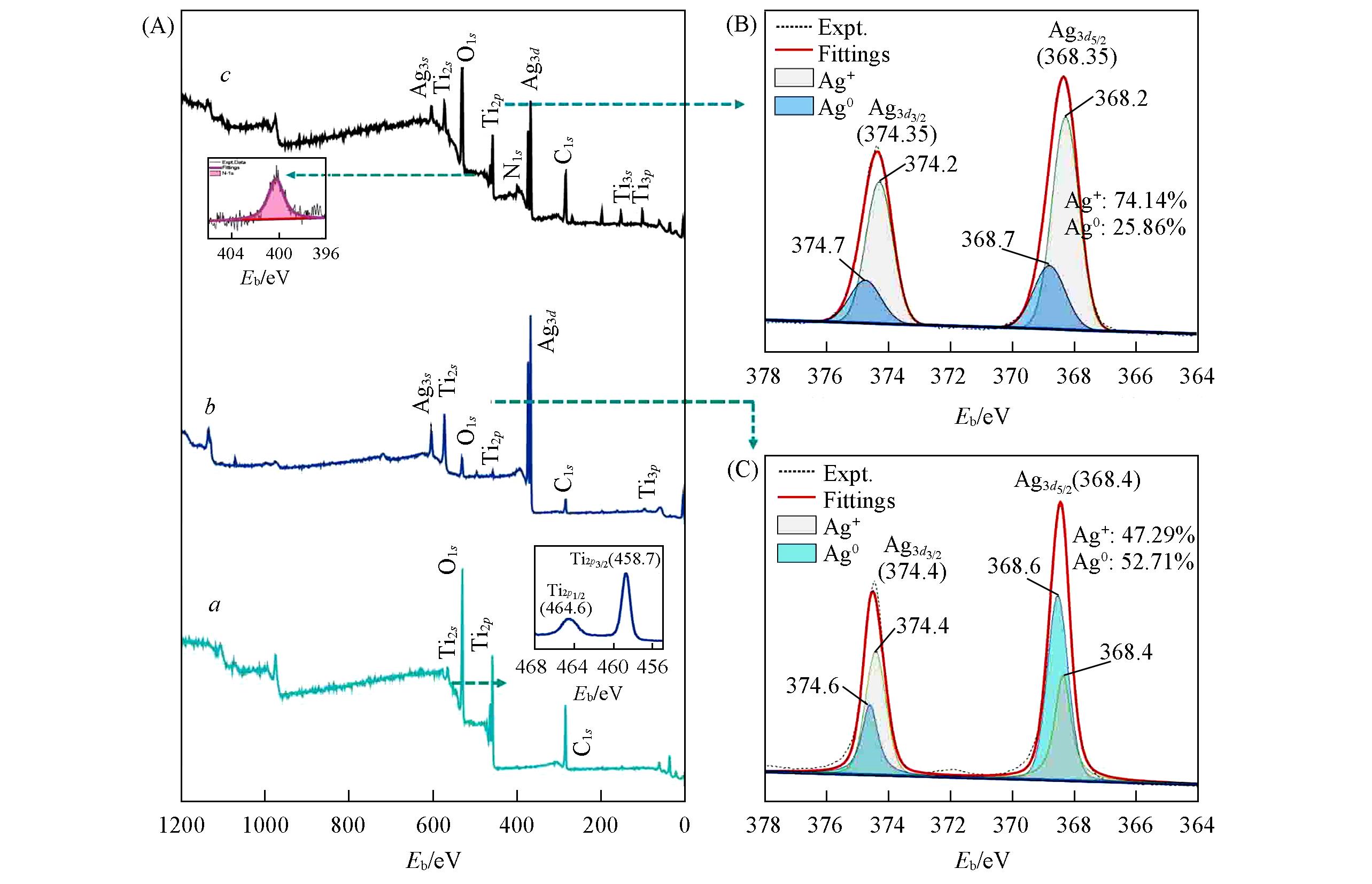
Fig.8 XPS of prepared TiO2 tetragonal prism nanoarray(a), TiO2@AgNPs?TSC(Time?60 min)(b) and TiO2@AgNPs?PVP(Tollens?0.8 mol/L)(c)(A), Ag3d core?level spectra of TiO2@AgNPs?PVP(B) and TiO2@AgNPs?TSC(C)
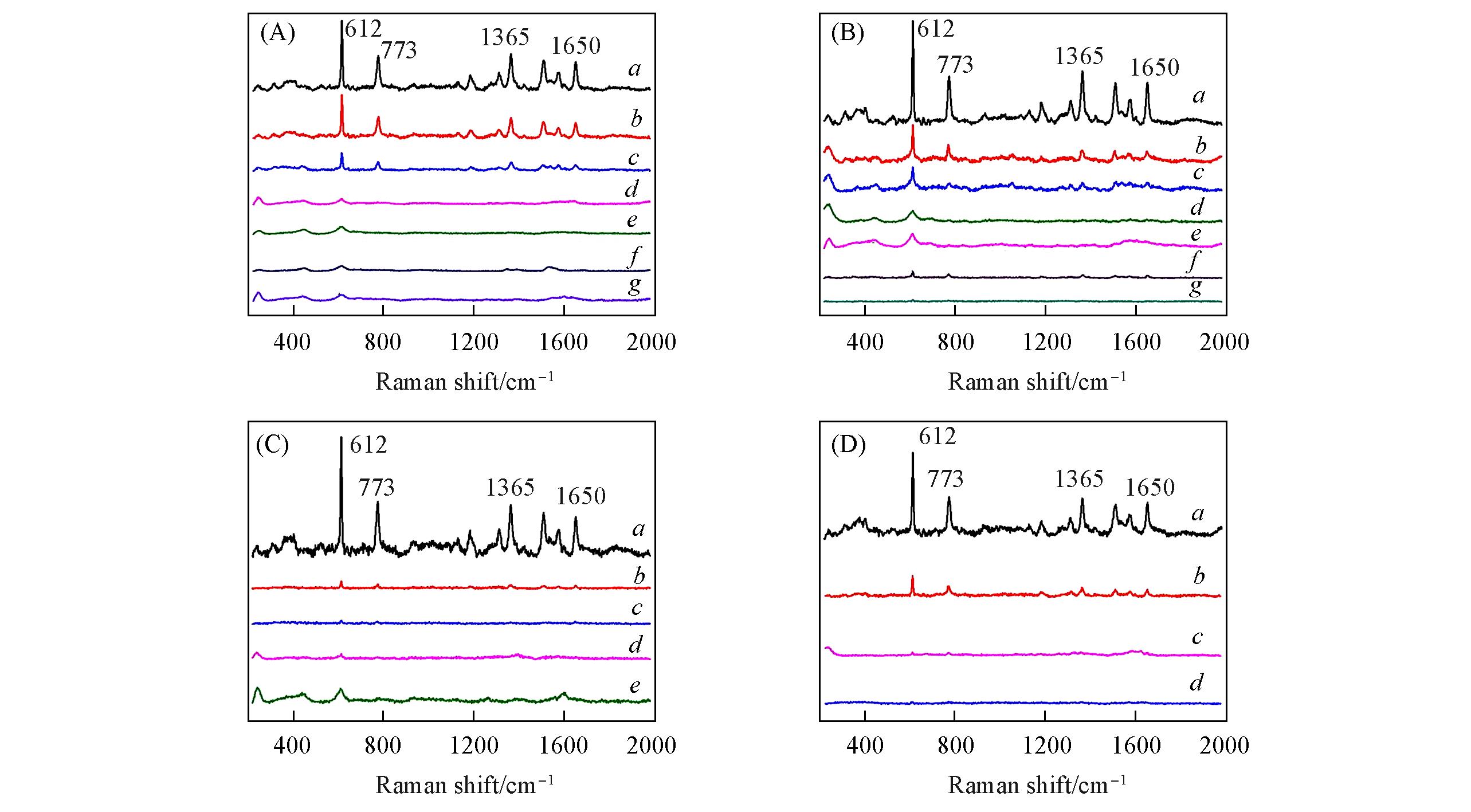
Fig.9 SERS spectra of R6G(concentration range in 10-5─10-12 mol/L) adsorbed on TiO2@AgNPs?PVP substrates prepared with different concentrations of Tollens(A) 0.4 mol/L; (B) 0.8 mol/L; (C)1.2 mol/L; (D) 1.6 mol/L. c(R6G)/(mol·L-1): a. 10-5; b. 10-6; c. 10-7; d. 10-8; e. 10-9; f. 10-10; g. 10-12.
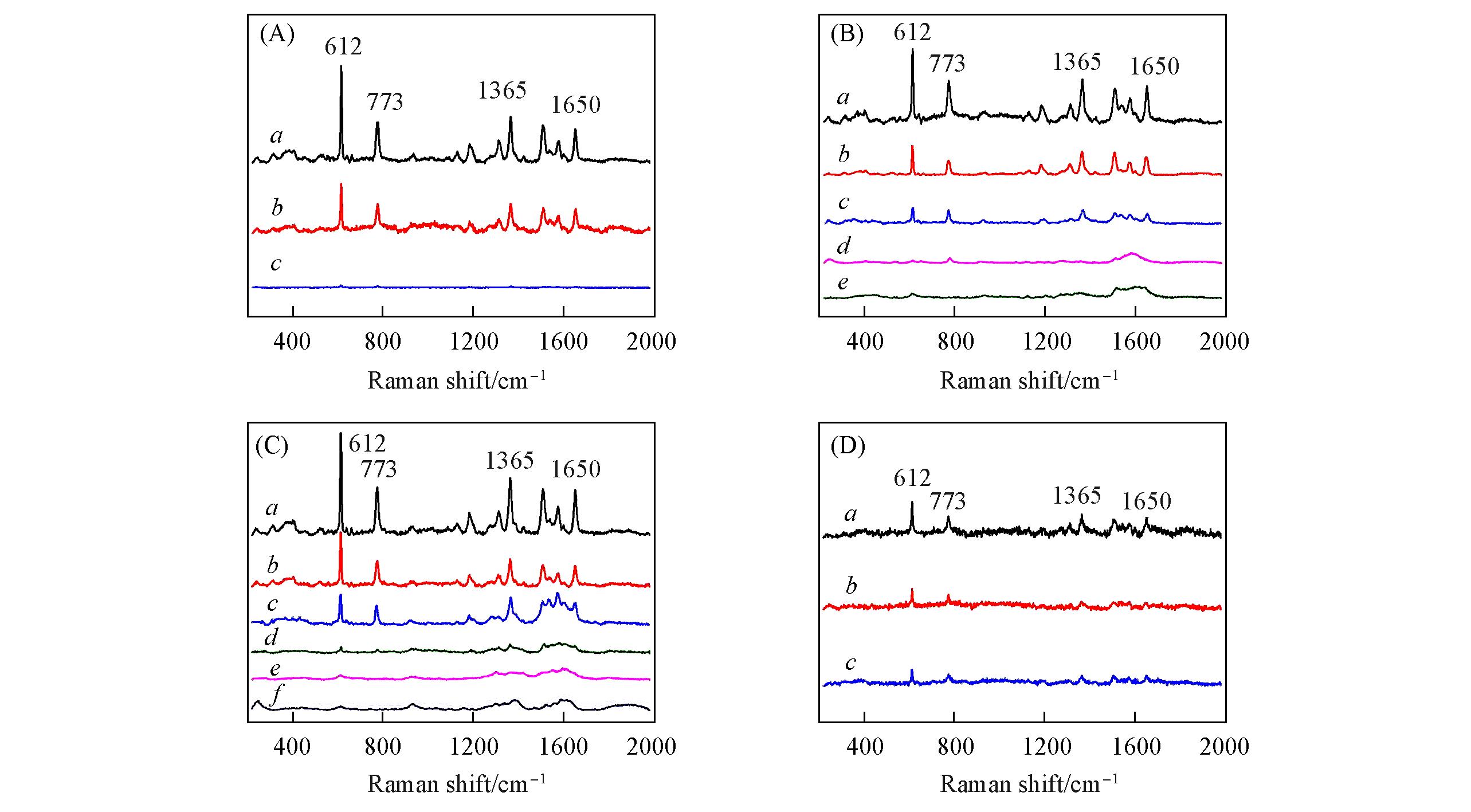
Fig.10 SERS spectra of R6G(concentration range in 10-5―10-12 mol/L) adsorbed on TiO2@AgNPs?TSC substrates prepared at different reaction time(A) 20 min, (B) 40 min, (C) 60 min, (D) 80 min. c(R6G)/(mol·L-1): a. 10-5; b. 10-6; c. 10-7; d. 10-8; e. 10-9; f. 10-10.
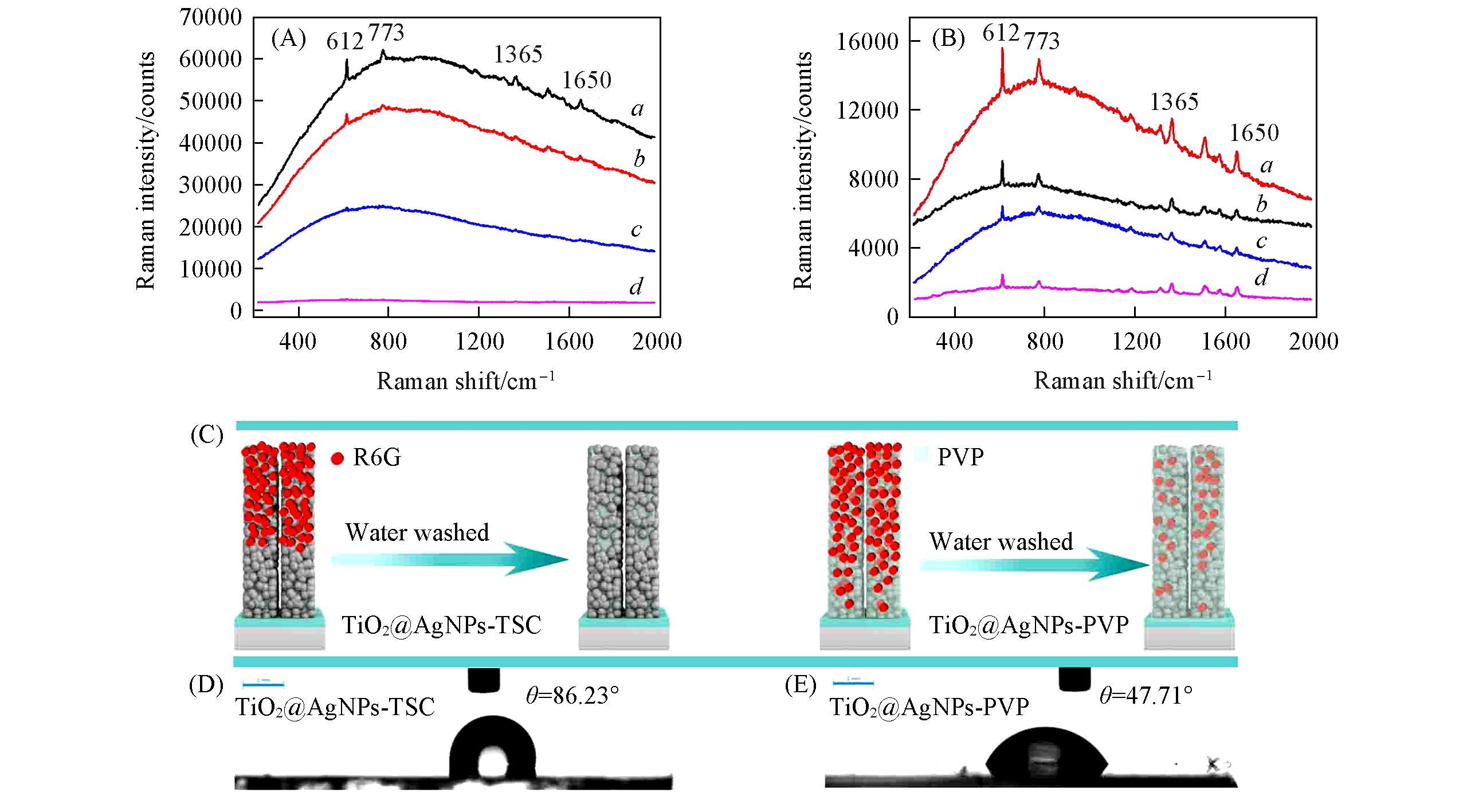
Fig.12 SERS spectra of 10-5 mol/L R6G adsorbed on TiO2@AgNPs?TSC(A) and TiO2@AgNPs?PVP(B) substrates along with the washed time, schematic diagram of R6G adsorbed on TiO2@AgNPs?TSC and TiO2@AgNPs?PVP substrates washed by water(C) and the contact angles of TiO2@AgNPs?TSC substrate(D) and TiO2@AgNPs?PVP substrate(E)a. Unwashed; b. washed?10 min; c. washed?60 min; d. washed?24 h.
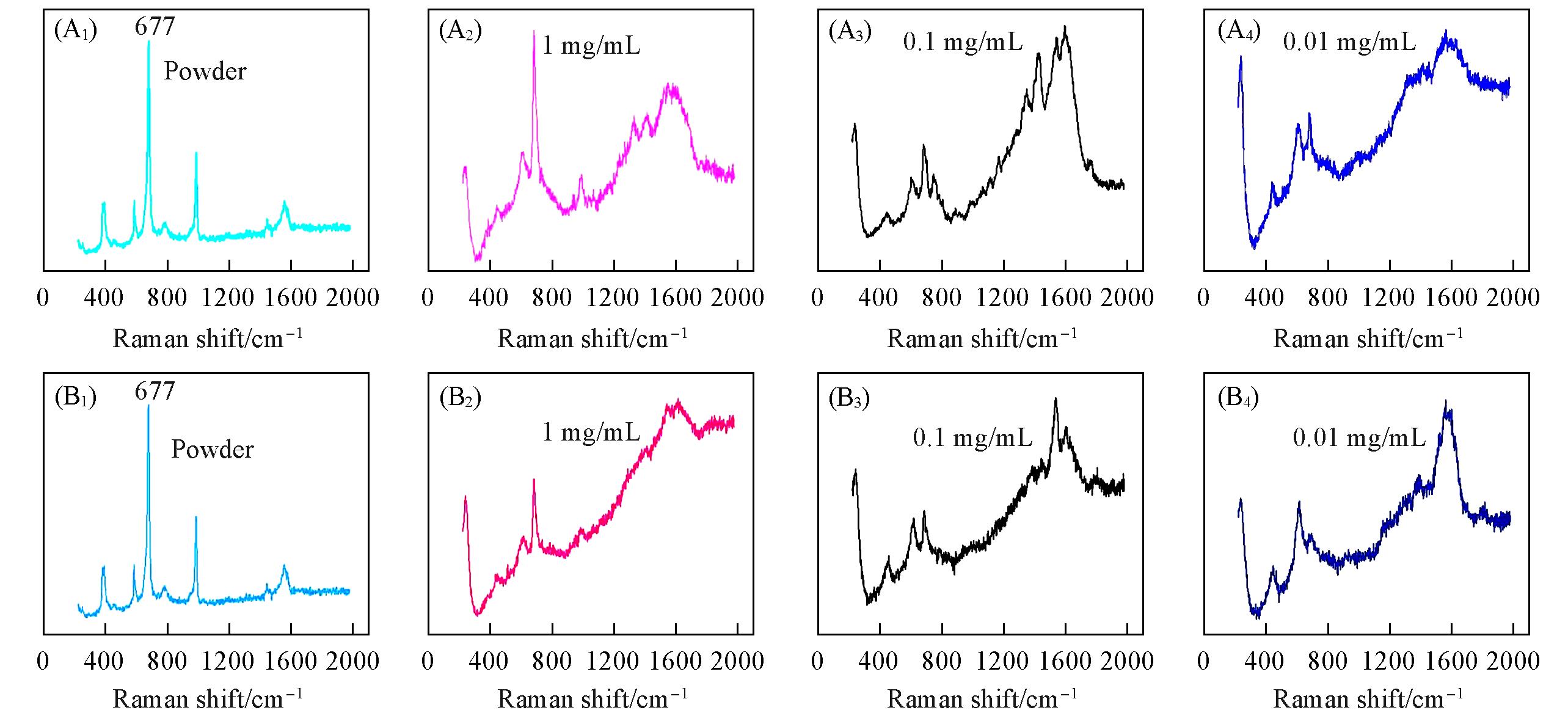
Fig.13 Raman(A1, B1) and SERS spectra(A2―A4, B2―A4) of melamine(0.01―1 mg/mL) adsorbed on TiO2@AgNPs?PVP substrate(Tollens?0.8 mol/L)(A1―A4) and TiO2@AgNPs?TSC substrate(Time?60 min)(B1―B4)
| 1 | Fleischmann M., Hendra P. J., McQuillan, A. J., Chem. Phys. Lett., 1974, 26(2), 163―166 |
| 2 | Nie S., Emory S. R., Science, 1997, 275(5303), 1102―1106 |
| 3 | Lombardi J. R., Birke R. L., Accounts Chem. Res., 2009, 42(6), 734―742 |
| 4 | Lindquist N. C., de Albuquerque C. D. L., Sobral⁃Filho R. G., Pac I., Brolo A. G., Nat. Nanotech., 2019, 14(10), 981―987 |
| 5 | Lee H. K., Lee Y. H., Koh C. S. L., Phan⁃Quang G. C., Han X., Lay C. L., Ling, X. Y., Chem. Soc. Rev., 2019, 48(3), 731―756 |
| 6 | Fang W., Jia S., Chao J., Wang L., Duan X., Liu H., Liu N., Sci. Adv., 2019, 5(9), eaau4506 |
| 7 | Zhan P., Wen T., Wang Z. G., He Y., Shi J., Wang T., Ding B., Angew. Chem. Int. Ed., 2018, 57(11), 2846―2850 |
| 8 | Ji W., Zhao B., Ozaki, Y., J. Raman Spectrosc., 2016, 47(1), 51―58 |
| 9 | Wang R., Yan X., Ge B., Zhou J., Wang M., Zhang L., Jiao T., ACS Sustain. Chem. Eng., 2020, 8(11), 4521―4536 |
| 10 | Lu Y., Liu G. L., Lee L. P. , Nano Lett., 2005, 5(1), 5―9 |
| 11 | Mengesha Z. T., Yang J., Anal. Chem., 2016, 88(22), 10908―10915 |
| 12 | Itoh T., Yamamoto Y. S., Kitahama Y., Balachandran J., Phys. Rev. B, 2017, 95(11), 115441 |
| 13 | Kim H., Jang H., Moon J., Byun J., Jeong J., Jung J., Kang T., Adv. Mater. Interf., 2019, 6(13), 1900427 |
| 14 | Bhattacharjee G., Bhattacharya M., Roy A., Senapati D., Satpati B., ACS Appl. Nano Mater., 2019, 1(10), 5589―5600 |
| 15 | Zhu C., Meng G., Zheng P., Huang Q., Li Z., Hu X., Wu N., Adv. Mater., 2016, 28(24), 4870―4870 |
| 16 | Zhang Y., Yang C., Xue B., Peng Z., Cao Z., Mu Q., Xuan L., Sci. Rep., 2018, 8(1), 1―10 |
| 17 | Liang H., Li Z., Wang W., Wu Y., Xu, H., Adv. Mater., 2009, 21(45), 4614―4618 |
| 18 | McLellan J. M., Siekkinen A., Chen J., Xia Y., Chem. Phys. Lett., 2006, 427(1―3), 122―126 |
| 19 | Yi M., Zhang D., Wang P., Jiao X., Blair S., Wen X., Ming H., Plasmonics, 2011, 6(3), 515―519 |
| 20 | Hu C. L., Chen S. Y., Wang Y., Liu X. Q., Liu J. Y., Zhang W. H., Chen J., Zhang, W. Z., Talanta,2016, 161, 599―605 |
| 21 | Liebig F., Sarhan R. M., Prietzel C., Schmitt C. N., Bargheer M., Koetz, J., ACS Appl. Nano Mater., 2018, 1(4), 1995―2003 |
| 22 | Chen S. Y., Wang Y., Liu H., Hu C. L., Liu X. Q., Liu J. Y., Chinese J. Anal. Chem., 2017, 45(3), 374―380(陈韶云, 王圆, 刘辉, 胡成龙, 刘学清, 刘继延. 分析化学, 2017, 45(3), 374―380) |
| 23 | Hu L., Liu Y. J., Han Y., Chen P., Zhang C., Li C., Jiang S., J. Mater. Chem. C, 2017, 5(16), 3908―3915 |
| 24 | Zhang X. Y., Mo Y. L., Liu B., Hu C. L., Chen S. Y., Shi H., Chen J., ACS Appl. Nano Mater., 2018, 1(9), 4771―4780 |
| 25 | Huang J., Chen F., Zhang Q., Zhan Y., Ma D., Xu K., Zhao Y., ACS Appl. Mater. Interf., 2015, 7(10), 5725―5735 |
| 26 | Chen Z., Jia D. S., Zhou Y., Hao J., Liang Y., Cui Z. M., Song W. G., Appl. Surf. Sci., 2018, 434, 1137―1143 |
| 27 | Zhang Z., Wu Y., Wang Z., Zou X., Zhao Y., Sun L., Mater. Sci. Eng. C, 2016, 69, 462―469 |
| 28 | Wang Y., Zhang M., Fang L., Yang H., Zuo Y., Gao J., Sun Z., J. Am. Ceram. Soc., 2019, 102(7), 4000―4013 |
| 29 | Chen L., Luo L., Chen Z., Zhang M., Zapien J. A., Lee C. S., Lee S. T., J. Phys. Chem. C, 2010, 114(1), 93―100 |
| 30 | Wang Y., Zhang J., Jia H., Li M., Zeng J., Yang B., Lombardi J. R., J. Phys. Chem. C, 2008, 112(4), 996―1000 |
| 31 | Han X. X., Ji W., Zhao B., Ozaki Y., Nanoscale, 2017, 9(15), 4847―4861 |
| 32 | Zhang M., Chen T., Liu Y., Zhu J., Liu J., Wu Y., ChemNanoMat, 2019, 5(1), 55―60 |
| 33 | Wang W., Sang Q., Yang M., Du J., Yang L., Jiang X., Zhao B., Sci. Total Environ., 2020, 702, 134956 |
| 34 | Yang Y., Zhang Z., He Y., Wang Z., Zhao Y., Sun L. F., Sensors Actuat. B-Chem., 2018, 273, 600―609 |
| 35 | Li Q., Tian D., Chen S. Y., Zhong M., Hu C. L., Chen J., Chem. J. Chinese Universities, 2021, 42(3), 736―744(李奇, 田杜, 陈韶云, 钟敏, 胡成龙, 陈建. 高等学校化学学报, 2021, 42(3), 736―744) |
| 36 | Chen S. Y, Hu C. L., Zhang W. H, Chen J., ChemPlusChem, 2016, 81(2), 161―165 |
| 37 | Chen S. Y., Liu B., Zhang X Y., Mo Y L., Chen F., Shi H., Zhang W. H., Hu C. L., Chen J., Electrochim. Acta, 2018, 274, 242―49 |
| 38 | Zhang X. Y., Liu B., Hu C. L., Chen S. Y., Liu X. Q., Liu J. Y., Chen F., Chen J. Xie F. Y., Spectrochimica Acta A, 2020, 228, 117733 |
| 39 | Ding S. Y., Yi J., Li J. F., Ren B., Wu D. Y., Panneerselvam R., Tian Z. Q., Nat. Rev. Mater., 2016, 1(6), 1―16 |
| 40 | Feng Y., Wang Y., Wang H., Chen T., Tay Y Y., Yao L., Chen H., Small, 2012, 8(2), 246―251 |
| 41 | Yang L., Jiang X., Ruan W., Yang J., Zhao B., Xu W., Lombardi J. R., J. Phys. Chem. C, 2009, 113(36), 16226―16231 |
| 42 | Lin H., Ye H., Xu B., Cao J., Chen S., Catal. Commun., 2013, 37, 55―59 |
| 43 | Jiang B., Wang Y., Wang J. Q., Tian C., Li W., Feng Q., Fu H., ChemCatChem, 2013, 5(6), 1359―1367 |
| 44 | Zhang H., Wang G., Chen D., Lv X., Li J., Chem. Mater., 2008, 20(20), 6543―6549 |
| 45 | Ilić V., Šaponjić Z., Vodnik V., Molina R., Dimitrijević S., Jovančić P., Radetić M., J. Mater. Sci., 2009, 44(15), 3983―3990 |
| 46 | Tiwari V. S., Oleg T., Darbha G. K., Hardy W., Singh J. P., Ray P. C., Chem. Phys. Lett., 2007, 446(1―3), 77―82 |
| 47 | Wang X., Shi W., She G., Mu L., Lee S., Appl. Phys. Lett., 2010, 96, 053104 |
| 48 | Nayak D. R., Bhat N., Venkatapathi M., Umapathy S., J. Mater. Chem. C, 2017, 5(8), 2123―2129 |
| [1] | 夏大成, 周瑞, 涂博, 蔡志伟, 高难, 姬晓旭, 常钢, 任小明, 何云斌. 银/金纳米线阵列表面增强拉曼基底的制备及对孔雀石绿的高灵敏度检测[J]. 高等学校化学学报, 2022, 43(3): 20210731. |
| [2] | 储瑶, 王烁, 张子诺, 王艺博, 蔡以兵. 铜粒子负载泡沫基相变复合材料的制备与性能[J]. 高等学校化学学报, 2022, 43(2): 20210619. |
| [3] | 李奇, 田杜, 陈韶云, 钟敏, 胡成龙, 陈建. 银纳米片在无纺布纤维上的可控组装及其SERS效应[J]. 高等学校化学学报, 2021, 42(3): 736. |
| [4] | 唐文涛, 李圣凯, 王昚, 陈龙, 陈卓. 基于激光介导富集的表面增强拉曼分析[J]. 高等学校化学学报, 2021, 42(10): 3054. |
| [5] | 张梦瑶, 余仁鹏, 韩梅, 刘建芳, 李末霞, 胡家文, 田中群. 盐诱导金纳米粒子自组装和沉降制备具有宽波段吸收特性的黑金[J]. 高等学校化学学报, 2020, 41(8): 1903. |
| [6] | 王晓如,张娜,邢钧. 基于多齿功能单体的三聚氰胺印迹材料的制备及应用[J]. 高等学校化学学报, 2020, 41(7): 1521. |
| [7] | 刘帅卓,张骞,刘宁,肖文艳,范雷倚,周莹. 三聚氰胺海绵的一步式协同超疏水改性及在油水分离中的应用[J]. 高等学校化学学报, 2020, 41(3): 521. |
| [8] | 冯微, 王博蔚, 姜洋, 李龙云. 银纳米粒子簇的设计、 制备和表面增强拉曼光谱[J]. 高等学校化学学报, 2019, 40(7): 1345. |
| [9] | 齐琪, 鲁冰新, 车玉萍, 汪洋, 翟锦. 双金属双硅层核-壳纳米结构Au@SiO2@Ag@SiO2用于葡萄糖检测[J]. 高等学校化学学报, 2019, 40(5): 887. |
| [10] | 王稳, 陶霞芳, 吴赟炎, 赵南, 程晓农, 杨娟, 周亚洲. 三明治结构纳米银/氧化石墨烯基底的制备及SERS性能[J]. 高等学校化学学报, 2019, 40(4): 667. |
| [11] | 袁宝明,董晓明,杨帆,彭传刚,王金成,吴丹凯. 载银离子PLGA-PEG-PLGA温度敏感水凝胶的制备及体外抗菌性能[J]. 高等学校化学学报, 2019, 40(10): 2225. |
| [12] | 薛佼, 王润伟, 张宗弢, 裘式纶. 新型Zn2+掺杂C/Nb2O5纳米催化剂的制备及光催化性能[J]. 高等学校化学学报, 2018, 39(2): 319. |
| [13] | 徐蔚青, 管树霖, 王祎, 王馨楠, 陶艳春, 徐抒平. 一种保护层可揭除的新鲜多级银SERS活性基底[J]. 高等学校化学学报, 2018, 39(12): 2752. |
| [14] | 邱丽娟, 张颖, 刘帅卓, 张骞, 周莹. 超疏水、 高强度石墨烯油水分离材料的制备及应用[J]. 高等学校化学学报, 2018, 39(12): 2758. |
| [15] | 阿山, 郑家威, 刘聚明, 白杰, 杨桔材, 张前程. 乙酸修饰Ag/TiO2复合光催化剂的制备及协同催化性能[J]. 高等学校化学学报, 2017, 38(8): 1450. |
| 阅读次数 | ||||||
|
全文 |
|
|||||
|
摘要 |
|
|||||